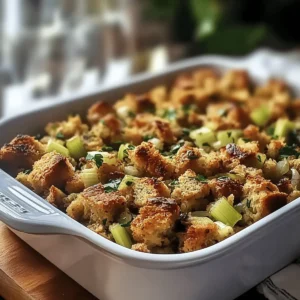As I stood in my kitchen, the familiar scent of sautéed onion and celery wafted through the air, transporting me to countless Thanksgiving gatherings filled with laughter and warmth. This isn’t just any recipe; it’s Grandma’s Thanksgiving Stuffing, a family tradition that has graced our holiday table for generations. This comforting side dish combines stale bread and fresh vegetables, creating a perfect base for all sorts of imaginative add-ins. Whether you opt for savory sausage or sweet dried fruits, this stuffing is not only customizable but also easy to whip up in no time. With its inviting flavors, it’s bound to become a beloved staple for your festive celebrations. So, are you ready to bring a taste of nostalgia to your Thanksgiving feast?
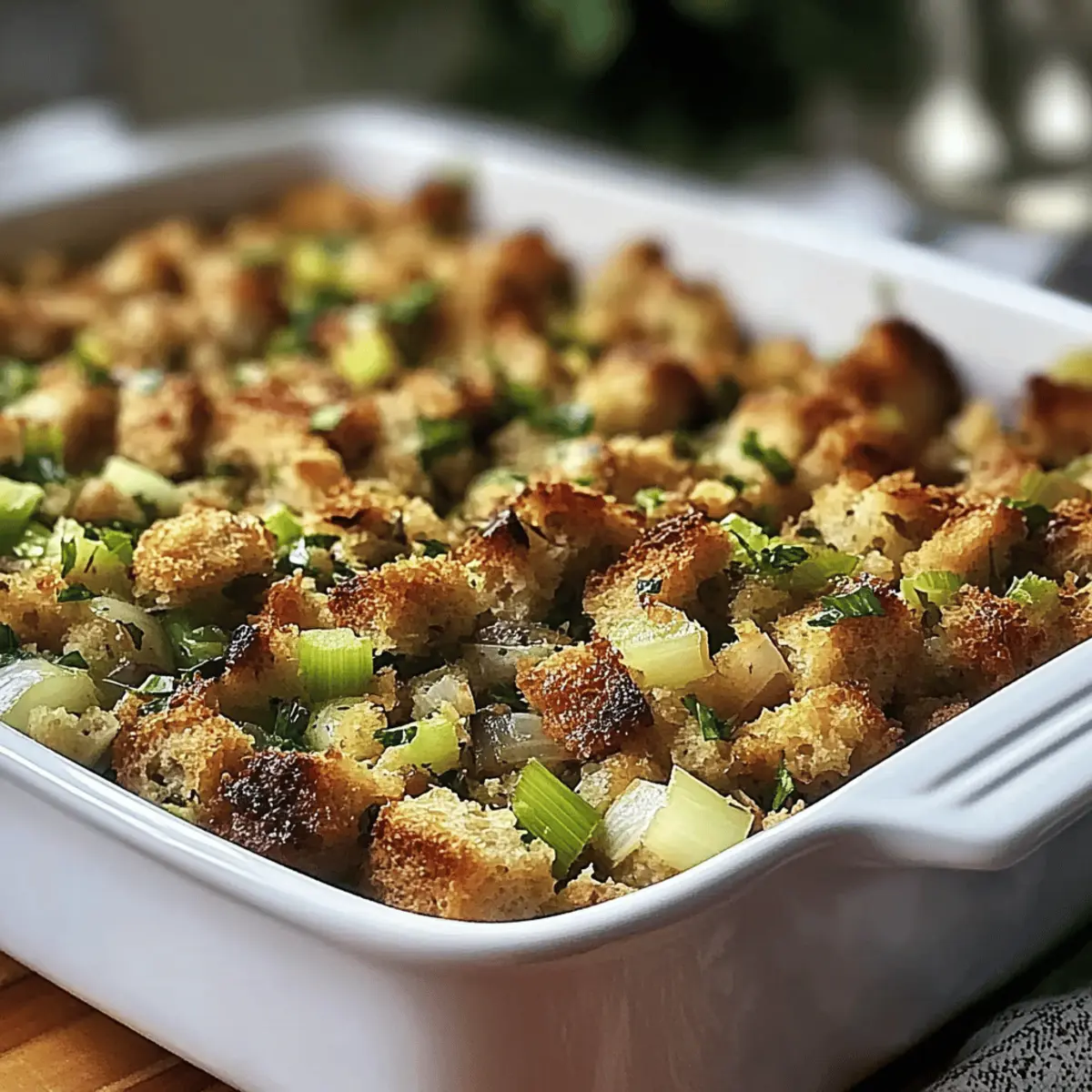
Why Is This Stuffing Recipe So Special?
Homemade Comfort: There’s nothing like preparing a classic dish that echoes family memories. Grandma’s Thanksgiving Stuffing brings warmth and nostalgia to your table.
Customizable Flavors: Feel free to mix in your favorite ingredients! From savory sausage to sweet cranberries, the variations are endless.
Easy Preparation: This recipe is straightforward, making it a perfect option for novice cooks or seasoned chefs alike.
Crowd-Pleasing Delight: It pairs wonderfully with turkey, mashed potatoes, and gravy, ensuring it’s a hit at any holiday gathering.
Make-Ahead Friendly: You can prep this stuffing in advance, saving you time for other festive dishes. Cheers to a stress-free Thanksgiving!
Thanksgiving Stuffing Ingredients
For the Bread Base
• Stale Bread – Use about 10 cups of cubed stale sourdough or French bread; stale bread best absorbs flavors without being mushy.
For the Flavor
• Yellow Onion – Use one large onion, finely diced, sauté until translucent for enhanced sweetness and depth.
• Celery – Use approximately 2 cups, finely chopped; sauté alongside onion to soften while maintaining some delightful crunch.
• Fresh Herbs (Sage, Thyme, Rosemary) – Use 2 tablespoons each of fresh sage and thyme, plus 1 tablespoon of finely chopped rosemary for traditional herbaceous notes and rich flavor.
For Binding and Moisture
• Low-Sodium Broth (Chicken or Vegetable) – Use about 4 cups, warmed; acts as a binding agent, providing moisture and richness to your Thanksgiving stuffing.
• Unsalted Butter – Use ½ cup melted; enhances richness and moisture without overpowering the dish.
Step‑by‑Step Instructions for Thanksgiving Stuffing
Step 1: Preheat the Oven
Start by preheating your oven to 350°F (175°C). While the oven warms up, grease a large baking dish with cooking spray or butter to prevent the Thanksgiving stuffing from sticking. This step ensures your dish comes out beautifully golden and easy to serve.
Step 2: Sauté the Vegetables
In a large skillet, melt ½ cup of unsalted butter over medium heat. Once melted, add the finely diced yellow onion and sauté for about 5-7 minutes, stirring occasionally until the onion is translucent and fragrant. Then, add approximately 2 cups of finely chopped celery to the skillet and cook for an additional 3-4 minutes until softened but still crunchy.
Step 3: Mix the Bread and Aromatics
In a spacious mixing bowl, combine about 10 cups of cubed stale sourdough or French bread with the sautéed onion and celery mixture. Gently fold the ingredients together, ensuring the flavorful vegetable medley disperses evenly among the bread cubes. This mixture will form the heart of your Thanksgiving stuffing.
Step 4: Add Fresh Herbs and Seasoning
Sprinkle in 2 tablespoons each of fresh sage and thyme, and 1 tablespoon of finely chopped rosemary into the bread mixture. Season generously with salt and pepper, stirring carefully to evenly distribute the herbs and seasonings. This step elevates the flavor profile, creating a warm and inviting aroma that welcomes your guests.
Step 5: Incorporate the Broth
Gradually pour in about 4 cups of warmed low-sodium broth, whether chicken or vegetable, while mixing gently to combine. Be careful not to overly saturate the mixture; it should be moist but not soggy. Aim for a consistency that allows the Thanksgiving stuffing to hold together while still retaining texture.
Step 6: Transfer to Baking Dish
Carefully transfer the stuffing mixture into your greased baking dish, spreading it out evenly. Use a spatula to ensure that the stuffing is packed loosely but uniformly, which helps it cook through. Cover the dish with aluminum foil before placing it in the oven to retain moisture throughout the baking process.
Step 7: Bake the Stuffing
Place the covered baking dish in the preheated oven and bake for 30 minutes. After this time, remove the foil to allow the top of the Thanksgiving stuffing to crisp up. Continue baking uncovered for an additional 15 minutes, or until the stuffing is golden brown and the edges are slightly crispy, creating a delightful contrast in texture.
Step 8: Cool and Serve
Once baked to perfection, remove the stuffing from the oven and let it cool for a few minutes before serving. This resting period helps the flavors meld together beautifully and allows for easier scooping. Serve your comforting Thanksgiving stuffing alongside your favorite holiday dishes, bringing joy and warmth to your table.
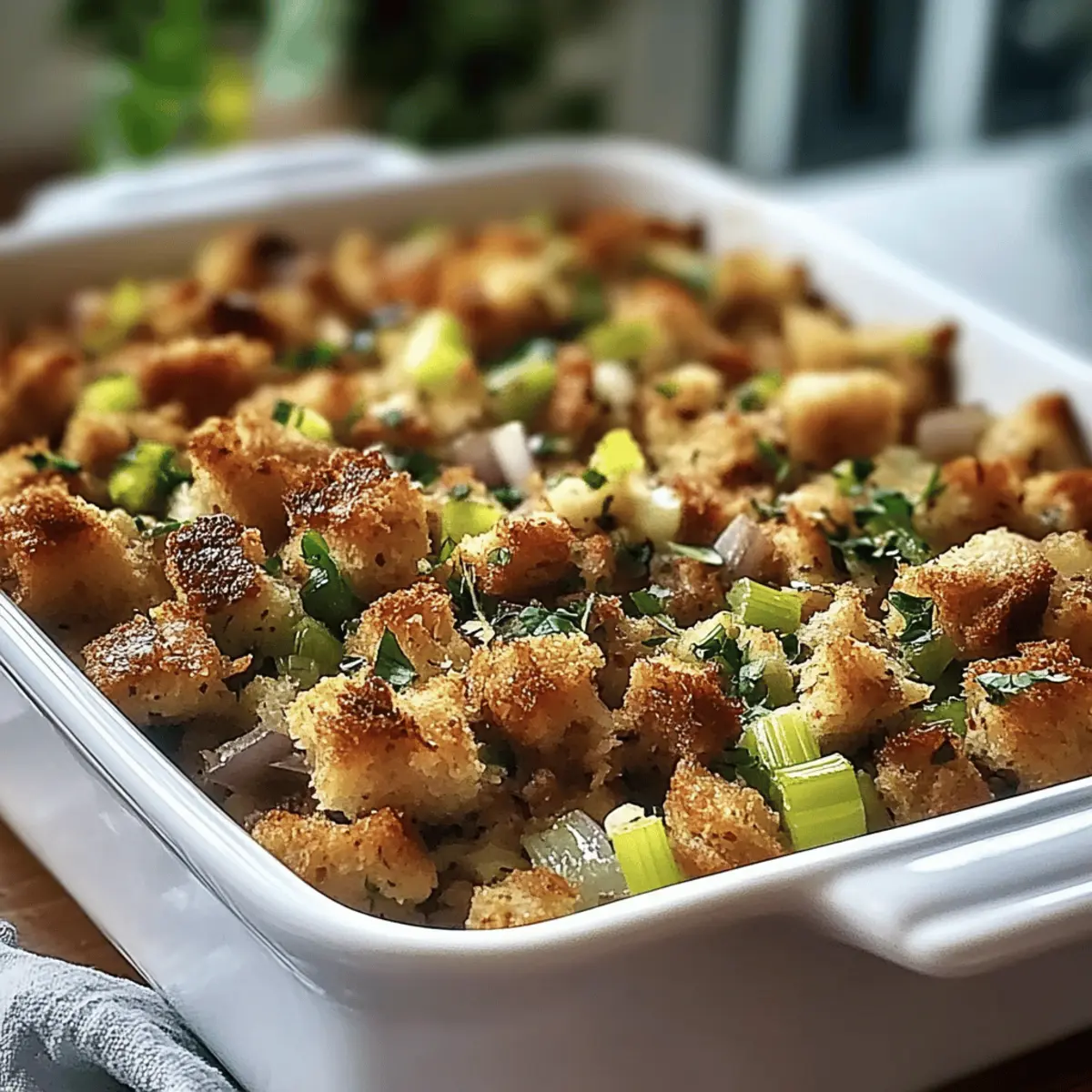
Variations & Substitutions for Thanksgiving Stuffing
Feel free to explore endless possibilities that amplify flavors and textures for a truly unique dish!
- Savory Sausage: Add cooked sausage or diced bacon for a rich, mouthwatering twist that enhances flavor and heartiness. Imagine each bite bursting with flavor as the savory meat melds with the herbs and vegetables.
- Fruity Delight: Mix in dried fruits like cranberries or apricots, introducing a pleasant sweetness that complements the stuffing’s savory depth. As these treasures soften during baking, they become delightful bursts of flavor!
- Nutty Crunch: Try adding nuts such as pecans or walnuts for added crunch and texture. They provide a satisfying contrast to the soft bread and sautéed veggies, creating a wonderful mouthfeel with each bite.
- Broth Upgrade: Substitute the broth with homemade turkey broth for a deeper, more complex flavor profile. The richness adds an authentic touch that will impress your guests and elevate your holiday fare.
- Gluten-Free Option: Adjust to dietary needs by using gluten-free bread, ensuring everyone can enjoy this classic dish—it’s a delicious option for gluten-sensitive guests without sacrificing flavor.
- Vegan-Friendly: Swap out the butter for vegan butter and use vegetable broth to create a vegan version of this comforting dish, maintaining the essence of Grandma’s recipe while accommodating different diets.
- Herb Twist: Experiment with different herbs such as parsley or dill if you want a fresh twist that brightens the dish. These herbs can add a refreshing contrast to the richness of the stuffing’s base flavors.
- Heat It Up: Introduce a splash of hot sauce or diced jalapeños for a spicy kick that can ignite your taste buds. This unexpected heat provides an exciting contrast in the traditionally mild flavor of stuffing.
Looking for more guidance? Dive into my suggestions for Serving Suggestions that’ll enhance your holiday spread!
Make Ahead Options
Grandma’s Thanksgiving stuffing is perfect for meal prep, saving you precious time in the kitchen during the holiday rush! You can chop the vegetables and cube the stale bread up to 24 hours in advance, storing them in separate airtight containers in the refrigerator to maintain freshness. Additionally, you can mix the bread with the sautéed vegetables and herbs, refrigerating this mixture for up to 3 days. When you’re ready to bake, simply add the broth, transfer to your baking dish, and follow the final baking instructions. This way, you’ll have a homemade, heartwarming dish that’s just as delicious as if made fresh on the day!
How to Store and Freeze Thanksgiving Stuffing
Fridge: Store leftover Thanksgiving stuffing in an airtight container for up to 3-4 days. Let it cool completely before sealing to maintain freshness.
Freezer: Freeze stuffing in a freezer-safe container or tightly wrapped in aluminum foil for up to 3 months. Thaw in the fridge overnight before reheating.
Reheating: Reheat in the oven at 350°F (175°C) for about 20-25 minutes, adding a splash of broth to restore moisture and ensure a comforting texture.
Make-Ahead: Prepare the stuffing a day in advance and keep it covered in the fridge until you’re ready to bake, making your Thanksgiving preparation a breeze!
Expert Tips for Thanksgiving Stuffing
-
Quality Ingredients Matter: Use fresh herbs and high-quality bread for optimal flavor. Stale bread absorbs seasoning better, enhancing your Thanksgiving stuffing.
-
Season Generously: Always taste the mixture before baking. Adding more salt and pepper at this stage ensures your stuffing is flavorful and satisfying.
-
Moisture Control: Aim for a consistency that’s moist but not soggy. Adjust the amount of broth based on your bread’s dryness; every loaf varies!
-
Prep Ahead: Save time on Thanksgiving day by chopping vegetables and drying bread cubes in advance. This way, you can quickly pull everything together!
-
Experiment with Add-Ins: Feel free to add cooked sausage, nuts, or dried fruits to customize your Thanksgiving stuffing. Each addition brings a unique twist to the classic recipe.
What to Serve with Grandma’s Thanksgiving Stuffing
Imagine a beautifully set holiday table, where the warm aroma of roasted turkey fills the air and every dish complements each other in harmony.
- Roasted Turkey: A classic pairing, the juicy flavors of turkey elevate the stuffing, making every bite a festive delight.
- Creamy Mashed Potatoes: The buttery richness of mashed potatoes adds a smooth texture that beautifully contrasts the stuffing’s crunchiness.
- Green Bean Casserole: This dish introduces a delightful crunch from fried onions, along with creamy comfort that rounds out your meal.
- Cranberry Sauce: The tartness of cranberry sauce cuts through the savory flavors, adding a refreshing contrast to the stuffing.
- Gravy: Drizzle warm turkey gravy over the stuffing for added moisture and more umami depth in every mouthful.
- Homemade Dinner Rolls: Soft, fluffy rolls provide a perfect vessel for mopping up any leftover gravy or stuffing!
- Roasted Brussels Sprouts: Their crisp texture and slightly bitter flavor balance the savory stuffing while adding a touch of green to your plate.
- Festive Salad: A bright salad with cranberries, nuts, and a light vinaigrette can refresh the palate amidst heavier dishes.
- Pumpkin Pie: After a hearty meal, serve this classic dessert to finish off on a sweet note, encapsulating the essence of Thanksgiving.
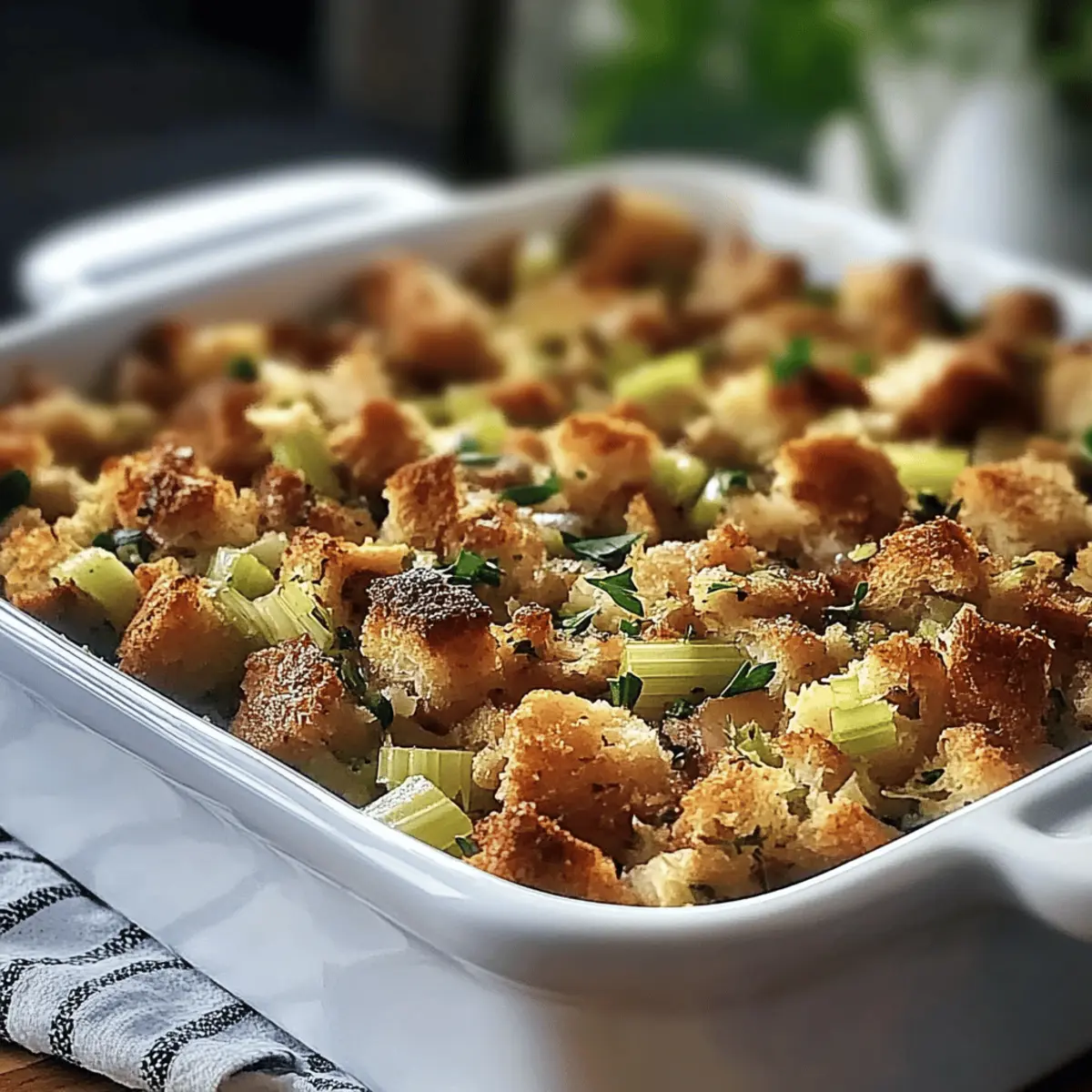
Thanksgiving Stuffing Recipe FAQs
What type of bread should I use for Thanksgiving stuffing?
Absolutely! For the best results, use stale bread, such as sourdough or French bread, as it absorbs flavors without becoming mushy. Aim for about 10 cups of cubed bread; if it feels a little dry, that’s perfect!
How should I store leftover Thanksgiving stuffing?
Very simple! Store any leftover Thanksgiving stuffing in an airtight container in the refrigerator for up to 3-4 days. Make sure it cools completely before sealing, which helps to lock in freshness.
Can I freeze Thanksgiving stuffing?
Yes, you can! To freeze your stuffing, place it in a freezer-safe container or tightly wrap it in aluminum foil. It can be stored for up to 3 months. When you’re ready to enjoy it again, thaw it in the fridge overnight.
How do I reheat Thanksgiving stuffing?
Reheating is a breeze! Preheat your oven to 350°F (175°C), then place the stuffing in a baking dish. Add a splash of broth to restore moisture and cover it with aluminum foil. Heat for about 20-25 minutes, ensuring it comes out warm and comforting.
Can I adjust this stuffing recipe for dietary needs?
Certainly! To cater to dietary restrictions, you can use gluten-free bread and vegan butter. Additionally, consider substituting low-sodium vegetable broth for chicken broth. This way, everyone can enjoy a delicious serving of Thanksgiving stuffing.
What should I do if my stuffing turns out too dry?
If you find your stuffing is dry, don’t worry! You can simply add a bit more warm broth, mixing gently until it reaches a moist but not soggy consistency. Adding the broth in small increments will help you achieve the perfect texture.
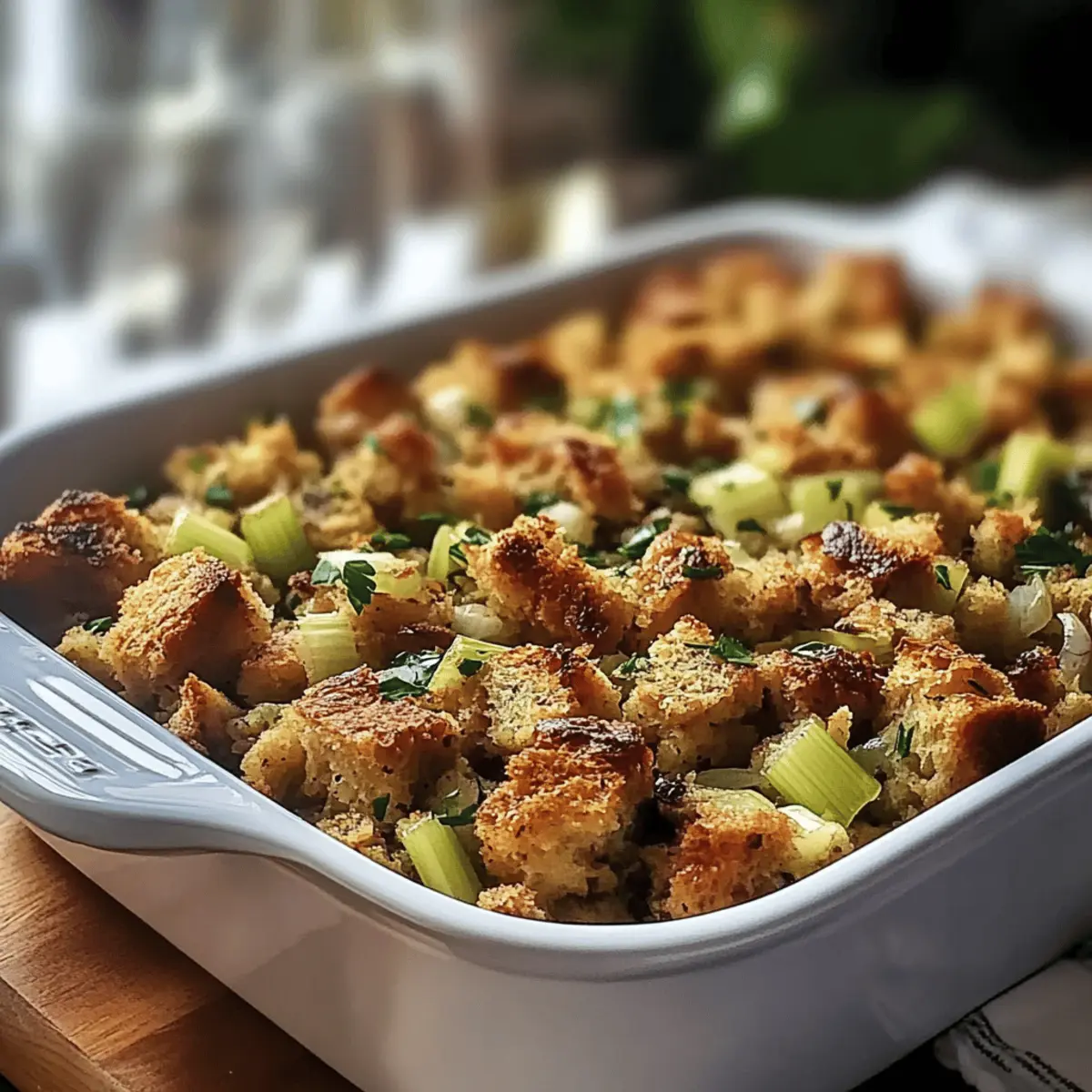
Grandma's Thanksgiving Stuffing: Comfort in Every Bite
Ingredients
Equipment
Method
- Preheat your oven to 350°F (175°C) and grease a large baking dish.
- Melt ½ cup of unsalted butter in a skillet over medium heat, then sauté the diced onion until translucent.
- Add chopped celery to the skillet and cook until softened.
- Combine the bread with the sautéed vegetables in a mixing bowl.
- Stir in the herbs and seasonings, mixing well.
- Gradually add the broth, mixing gently to avoid sogginess.
- Transfer the mixture to the greased baking dish and cover with foil.
- Bake covered for 30 minutes, then uncover and bake for an additional 15 minutes until golden brown.
- Let the stuffing cool for a few minutes before serving.

